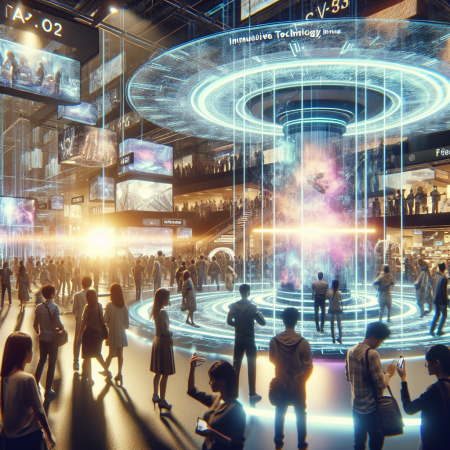Unlock unprecedented sales by integrating immersive technology in 2025
Understanding Immersive Technology
What is Immersive Technology?
Immersive technology encompasses various tools that enhance our interaction with digital content, making it feel as real as the physical world. As I dove into this topic, I discovered that virtual reality (VR), augmented reality (AR), and mixed reality (MR) are major players. They create experiences that literally pull users into a different reality, which can be a game changer for marketing.
This technology isn’t just a gimmick; it opens up rich storytelling avenues for brands. Imagine a customer stepping into a VR environment and experiencing your product firsthand. They’re not just seeing it; they’re living it! That’s what makes immersive technology so vital for sales strategies heading into 2025.
With chatbots and AI evolving rapidly, the immersive experience can make customers feel seen and heard, which is something that traditional marketing often lacks. I’ve seen firsthand how engaging with consumers on this level can significantly improve their emotional connection with a brand.
Creating Engaging Customer Experiences
The Power of Storytelling
Oh man, storytelling is everything! When you can weave a narrative around your product—especially using immersive tech—it becomes unforgettable. I remember attending a product launch event where they created a complete storyline around their product, and let me tell you, it was mesmerizing. It made all the difference in how the audience perceived the brand.
Through AR and VR, you can transport customers into an engaging environment that encapsulates your story. Instead of just presenting a product, you’re allowing the audience to interact directly with its narrative, which enhances understanding and retention.
Always aim for authenticity in your storytelling. Share your brand’s journey, its values, and how your product came to be. By making it relatable, you’ll ensure that an emotional connection is established. It’s this connection that drives sales.
Personalizing Marketing Efforts
Meet Your Customers Where They Are
Personalization is key to modern marketing! With immersive technology, I found that brands can tailor experiences to individual preferences. Have you ever been in a store that offers a virtual fitting room? That’s a perfect illustration of personalized marketing in action! The tech allows customers to see how a product fits them without trying it on, making the shopping experience more efficient and enjoyable.
Utilizing customer data to customize their shopping journey is a no-brainer. Tech like AI can analyze user behavior, suggesting products they might love based on past purchases. This level of personalization makes customers feel valued and understood, which ultimately boosts sales.
Don’t forget about feedback! After an experience, engaging customers through surveys or follow-ups not only provides invaluable insights but also shows your commitment to improving their experience. Remember, happy customers turn into loyal advocates!
Leveraging Social Media Integration
The Role of Social Platforms
Social media is where the action’s at these days! Integrating immersive technology within social platforms can massively amplify your marketing reach. For instance, imagine hosting an AR campaign on Instagram, allowing users to interact with your product right from their phone! That’s taking social engagement to a whole new level.
Social media isn’t just a place for engagement; it’s where modern consumers seek recommendations. Using immersive technology allows brands to showcase products dynamically and share customer experiences that resonate with a wider audience.
As a personal tip, leverage user-generated content. Encourage customers to share their experiences using your immersive tech. It adds authenticity to your brand and showcases real-life applications that potential customers love to see!
Establishing a Sustainable Competitive Edge
Staying Ahead of Trends
In this fast-paced world, being ahead of the game is crucial! By integrating immersive technology into your sales strategy, you’re not just keeping up; you’re paving the way for future trends. What impressed me most is how early adopters in this space have set themselves apart from competitors.
Don’t wait for trends to dictate your strategy—create them! Investing in the latest immersive technologies, whether it’s sophisticated AR apps or engaging VR content, positions your brand as a leader in innovation.
In my experience, continuous learning and adaptation are essential. Regularly update your tech, train your team on new tools, and keep an ear to the ground for emerging trends that can elevate your brand further. Embrace change, and your sales will follow suit.
Frequently Asked Questions
1. What types of immersive technology should I consider for my business?
When starting out, look into virtual reality (VR), augmented reality (AR), and mixed reality (MR). Each has unique applications that can significantly enhance customer engagement and sales.
2. How can storytelling impact my sales?
Storytelling can create emotional connections with customers, making your brand and products more relatable and memorable. A good story can elevate a simple product into an experiential journey.
3. Is personalization really effective in marketing?
Absolutely! Personalization makes customers feel understood and valued, which can lead to higher conversion rates and brand loyalty.
4. How do I integrate immersive technology with social media?
Utilize platforms like Instagram and Facebook to host immersive experiences, such as AR filters or VR interactions, to engage users directly where they spend their time online.
5. What steps should I take to keep ahead of industry trends?
Invest in ongoing education, stay updated with tech advancements, and pay attention to customer feedback and market research. Adapt and innovate to maintain your competitive edge.
Related Content
- The Art of Writing Newsletters That Feel Personal and Authentic
- How to Rank Higher on Google 2025: 7 Powerful Strategies for Success
- Win the mobile-first race with app-style website designs dominating 2025
- The Top 10 Benefits of Owning Your Own Business
- How to Create an Online Marketing Funnel for Your Business


